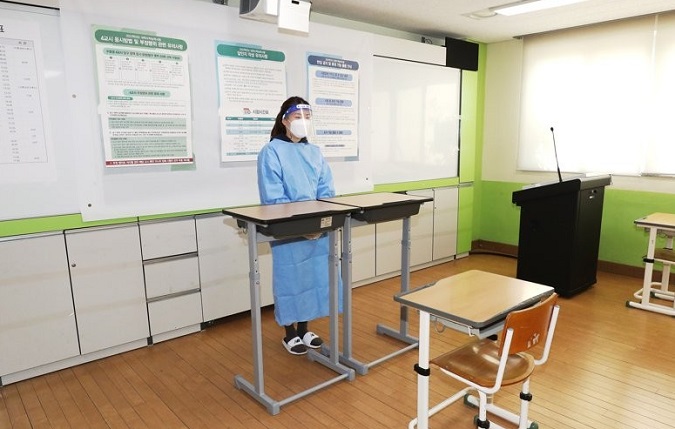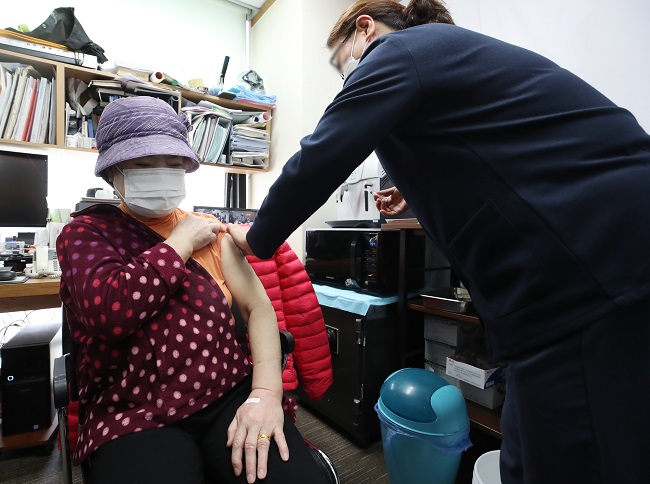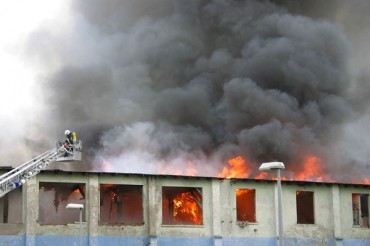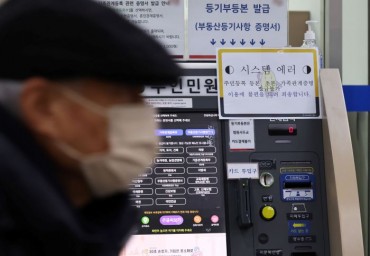
A proctor in full protective gear rehearses to supervise the college entrance test at a classroom for test-takers with COVID-19 symptoms at Areum High School in Sejong, central South Korea, on Nov. 16, 2021, two days before the test to be taken by 509,821 students nationwide amid the pandemic. (Yonhap)
SEOUL, Nov. 16 (Korea Bizwire) — The number of critically ill COVID-19 patients in South Korea hit an all-time high on Tuesday as the daily caseload hovered over 2,000 for the seventh consecutive day amid eased antivirus curbs.
The country reported 2,125 new COVID-19 cases, including 2,110 local infections, raising the total caseload to 399,591, according to the Korea Disease Control and Prevention Agency (KDCA).
The number of patients in serious condition came to the highest ever figure of 495, breaking the previous record of 485 cases on Saturday, it added.
The health authorities have said that they can manage around up to 500 seriously ill patients in a stable manner under the current medical capacity.
The country also added 22 more deaths from COVID-19, bringing the death toll to 3,137. The fatality rate stood at 0.79 percent.
As of 9 p.m. Tuesday, South Korea had reported 2,813 new cases across the country, up 969 from the previous day. The figure excluded cases from the southeastern city of Busan, which stopped releasing real-time data.
The Wednesday’s tally is expected to exceed 3,000. Cases are counted until midnight and announced the following morning.
The number of critically ill patients rose to over 400 on Nov. 6 for the first time since end-August and has been on the rise over the past week.
The bed occupancy rate in intensive care units for COVID-19 patients stood at 61.7 percent as of 5 p.m. Monday.
The figure in the greater Seoul area came to 76.1 percent, which passed the benchmark of 75 percent set by the health authorities for possible enforcement of an emergency response plan.
The government held a meeting with chiefs of general hospitals in Seoul and the surrounding areas on Tuesday to discuss ways to secure more beds and to better deal with the current situation.
Earlier this month, the government issued an administrative order twice dictating major hospitals in the region set aside a certain number of beds for seriously ill COVID-19 patients.
“Medical workers have been stretched thin as serious cases have risen at a fast pace. It is safe to say that beds for critical cases are fully occupied,” Jeong Hye-min, a professor at Seoul National University Hospital, said.
But the authorities said that the current situation does not require a halt to the ongoing eased social distancing scheme and the issuance of any contingency plans, as serious cases have been reported from specific facilities rather than any massive nationwide outbreak, and sending patients in metropolitan areas to other regions is still an available option.

A citizen receives a COVID-19 vaccine booster shot at a clinic in Seoul on Oct. 25, 2021, as South Korea began administering such shots for people aged 75 or older nationwide the same day. (Yonhap)
The hike in the daily caseload and the number of serious cases came as the effect of vaccinations has been tapering down for those who received the shots earlier this year.
South Korea initiated its vaccination campaign in February, with medical workers and senior citizens on its priority list.
Of the total 495 cases, people aged 60 or older accounted for 82.42 percent, and many of the fresh cases among those age groups have been reported from nursing homes.
The government said it is pushing to speed up administering booster shots.
Health Minister Kwon Deock-cheol told reporters on Monday that the government is reviewing a measure of shortening the interval between regular vaccine shots and additional ones from the current six months to five months or shorter.
The new plan on the vaccination program is expected to be announced Wednesday, the KDCA said.
As of Tuesday, 42.03 million people, or 81.8 percent of the country’s 52 million population, had received their first COVID-19 vaccine shots. The number of fully vaccinated people came to 40.19 million, or 78.3 percent.
Of the country’s 35.91 million vaccinated people, a total of 35,620 citizens, or 0.099 percent, had contracted the virus as of Nov. 7, according to the KDCA.
Among confirmed cases, the breakthrough cases accounted for 56 percent in the first week of November, up 26.3 percent from a month earlier, it added.
The growth in serious cases also came after the government eased monthslong strict antivirus restrictions under the “living with COVID-19″ scheme on Nov. 1 for a gradual return to pre-pandemic life. It seeks to fully lift the virus restrictions by end-February.
Under the first of the three-phase scheme, people are allowed to gather in groups of up to 10, regardless of vaccinations.
Operation hour curfews for businesses that cover restaurants, cafes and movie theaters are fully lifted, except for adult entertainment facilities, such as clubs and bars.
This week, the government plans to announce fresh, broad guidelines to determine the risk level of the virus to better respond to the pandemic under the eased curbs.
It is also working to draw up guidance on implementing “emergency action,” which could call for a halt to the current relaxation of antivirus curbs, according to the KDCA.
(Yonhap)






